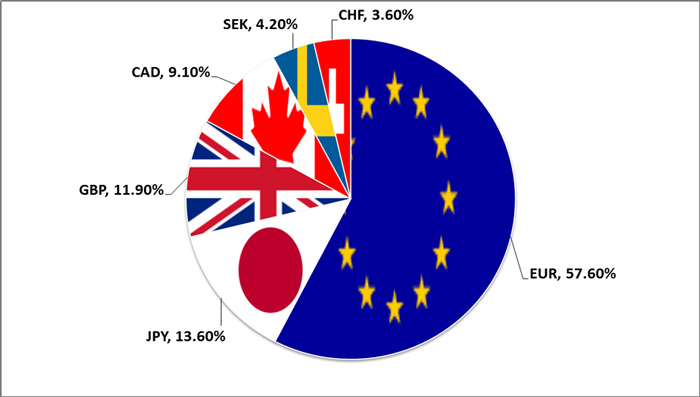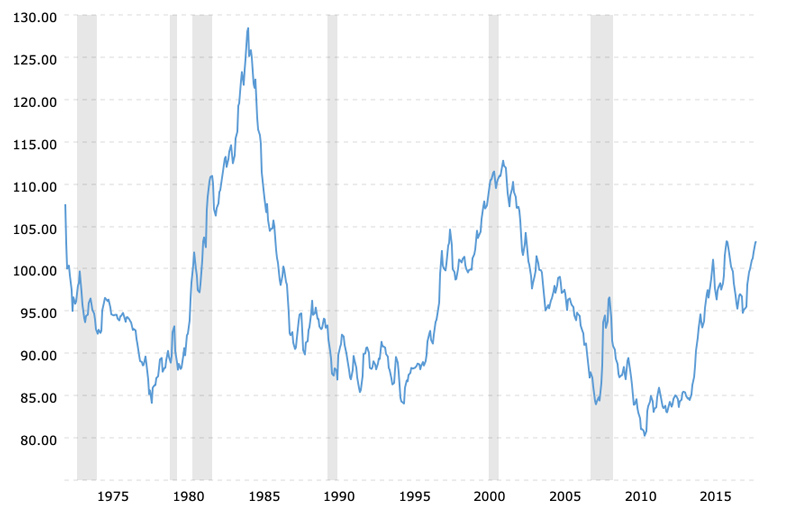What you are about to read:
The US Dollar Index (USDX), also known as DXY, is a currency index that measures the strength of the United States dollar against a basket of foreign currencies. Created by the Intercontinental Exchange (ICE) in 1973, this index is widely used as a benchmark for the performance of the U.S. dollar in the forex market.
In this article, we will delve into a detailed examination of the U.S. Dollar Index and its performance, brought to you by Brokerland.
What is the US Dollar Index?
The U.S. Dollar Index is composed of six major currencies, including the Euro (EUR), Japanese Yen (JPY), British Pound (GBP), Canadian Dollar (CAD), Swiss Franc (CHF), and Swedish Krona (SEK). This index is produced based on the trading volume of each currency with the United States.
The Euro holds the highest weight, accounting for approximately 57.6% of the Dollar Index, followed by the Japanese Yen with 13.6%, the British Pound with 11.9%, the Canadian Dollar with 9.1%, the Swedish Krona with 4.2%, and the Swiss Franc with 3.6%. The formula for calculating it is as follows:
USDX = 50.14348112 × EURUSD -0.576 × USDJPY 0.136 × GBPUSD -0.119 × USDCAD 0.091 × USDSEK 0.042 × USDCHF 0.036
The US Dollar Index (DXY) is calculated using a geometric-weighted average formula, taking into account the exchange rates of six currencies against the U.S. dollar. The index is set at 100.00 at its inception and is updated every 15 seconds based on the exchange rates of the base currencies. A higher USDX value indicates a stronger U.S. dollar, while a lower value indicates a weaker dollar.
Background of the U.S. Dollar Index
In 1973, the Federal Reserve created an official index (DXY) to track the value of the U.S. dollar. The tracking of the dollar’s value against certain foreign currencies began in 1971, after President Nixon abandoned the gold standard, allowing the dollar to float freely in global currency markets.
The value of the dollar constantly changes in response to fluctuations in forex transactions. Before the creation of the U.S. Dollar Index, the dollar was pegged at $35 per ounce of gold and had been so since the Bretton Woods Agreement in 1944.
The US Dollar Index started at 100. This index measures the percentage change in the value of the dollar since the establishment of the base value. Its highest record was on March 5, 1985, at 163.83, and its lowest price was on April 22, 2008, at 71.58, which is 28.4% lower than its inception.
The Dollar Index in Forex Trading
Forex traders use the US Dollar Index as a tool to measure the strength or weakness of the U.S. dollar against a basket of other currencies. This index provides traders with an overview of the performance of the US dollar in the forex market, making it an essential tool for analyzing trends in the financial market and making informed trading decisions.
The U.S. Dollar Index (USDX), especially in forex trading, is valuable as it allows traders to simultaneously analyze the performance of the U.S. dollar against multiple currencies. This information can assist traders in buying or selling the U.S. dollar pairs based on their expectations of future price changes.
For example, if the US Dollar Index is rising, it indicates that the U.S. dollar is strengthening against other currencies. As a result, traders may buy U.S. dollar pairs like USD/JPY or USD/CAD, expecting these currencies to increase against their counterparts.
Conversely, if the USDX is decreasing, it indicates a weakening U.S. dollar, and traders may sell U.S. dollar pairs to capitalize on potential price declines.
However, it is essential to note that the US Dollar Index is not a comprehensive indicator of the performance of the U.S. dollar in the forex market. This is because the index considers only six currencies, which may not accurately reflect the value of the U.S. dollar against other existing currencies. Additionally, other economic factors such as political instability, interest rates, and inflation can also impact the currency’s value.
Functions in the Forex Market
The US Dollar Index serves several crucial functions in the forex market, including:
Benchmark for U.S. Dollar Performance: The U.S. Dollar Index is widely used as a benchmark for the performance of the U.S. dollar in the forex market. It provides traders and investors with an overview of the strength or weakness of the U.S. dollar, enabling them to make informed decisions about buying or selling U.S. dollar pairs.
Hedging Tool: The U.S. Dollar Index can also be used as a hedging tool to reduce risk. For example, if a U.S. company has significant exposure to foreign currencies, it may use the U.S. Dollar Index to protect itself by taking a position in the index.
Economic Indicator: USDX can serve as an economic indicator, offering insights into the strength of the U.S. economy. If the index is increasing, it indicates U.S. economic growth, potentially having a positive impact on U.S. stocks and other assets. Conversely, a decreasing USDX may suggest a weakening U.S. economy, potentially negatively affecting U.S. assets.
Impact on Global Trade: The U.S. Dollar Index can also influence global trade, as the U.S. dollar is the dominant world currency for international trade. If the U.S. dollar strengthens, it may make U.S. goods more expensive, potentially impacting U.S. exports. Conversely, a weaker U.S. dollar may make U.S. goods cheaper and could potentially boost U.S. exports.
Impact on Commodities: US Dollar Index can also affect commodity prices, as many commodities, such as gold and oil, are priced in U.S. dollars. A stronger U.S. dollar can make these commodities more expensive for foreign buyers, potentially reducing demand and negatively affecting prices. Conversely, a weaker U.S. dollar may make these commodities cheaper for foreign buyers, potentially increasing demand and positively impacting prices.
Conclusion
The U.S. Dollar Index is a crucial tool in the forex market, providing traders and investors with an overall view of the performance of the U.S. dollar against a basket of foreign currencies. The index serves various vital functions, acting as a benchmark, hedging tool, economic indicator, and influencing global trade and commodity prices.
However, it’s important to recognize that DXY is not a complete indicator, and it should be used in conjunction with other analytical tools for making informed trading decisions. Like any investment, there are risks, and traders should exercise necessary caution before engaging in any transactions.











